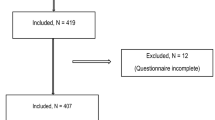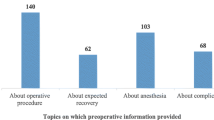Abstract
Background
Depression is the most common mental disease in patients hospitalized with physical illness. Disorders of anxiety and depression in general hospitals are frequently underdiagnosed and inappropriately treated.
Aim
To assess the prevalence of undiagnosed anxiety and depression in surgical inpatients and assess the referral rate and utilization of liaison psychiatry services.
Methods
A prospective study of surgical admissions (n = 96) to two surgical services at two separate institutions between 01/01/05 and 31/12/05. The Hospital Anxiety and Depression (HADS) scale was used to evaluate all patients.
Results
About 12.5% of patients had significant depression, 18.75% had significant anxiety, and 8.3% had significant mixed anxiety and depression. About 22.9% of patients warranted referral to liaison psychiatry services for further assessment and management.
Conclusions
Anxiety and depression are highly prevalent in surgical inpatients. An increased awareness of the possibility of undiagnosed psychiatric disorders is required, along with prompt and appropriate use of liaison psychiatry services.


Similar content being viewed by others
References
Kessler RC, Berglund P, Demler O, Jin R, Koretz D, Merikangas KR, Rush AJ, Walters EE, Wang PS (2003) National Comorbidity survey replication. The epidemiology of major depressive disorder: results from the National Comorbidity Survey Replication (NCS-R). JAMA 2003 289(23):3095–3105
Simon GE, Von Korff M, Lin E (2005) Clinical and functional outcomes of depression treatment in patients with and without chronic medical illness. Psychol Med 35(2):271–279
Smaira SI, Kerr-Correa F, Contel JO (2003) Psychiatric disorders and psychiatric consultation in a general hospital: a case- control study. Rev Bras Psiquiatr 25(1):18–25
Koenig HG, Blazer DG (1992) Epidemiology of geriatric affective disorders. Clin Geriatr Med 8(2):235–251
Silverstone PH, Lemay T, Elliot J, Hsu V, Starko R (1996) The prevalence of major depressive disorder and low self-esteem in medical inpatients. Can J Psychiatry 41(2):67–74
Huyse FJ, Herzog T, Lobo A, Malt UF, Opmeer BC, Stein B, de Jonge P, van Dijck R, Creed F, Crespo MD, CArdso G, Guimaraes-Lopes R, Mayou R, Van Moffaert M, Rigatelli M, Sakkas P, Tienari P (2001) Consultation-Liaison psychiatric service delivery: results from a European study. Gen Hosp Psychiatry 23(3):124–132
Koenig HG, George LK, Meader KG (1997) Use of antidepressants by nonpsychiatrists in the treatment of medically ill hospitalized depressed elderly patients. Am J Psychiatry 154(10):1369–1375
Oldridge N, Gottlieb M, Guyatt G, Jones N, Streiner D, Feeny D (1998) Predictors of health related quality of life with cardiac rehabilitation after acute myocardial infarction. J Cardiopulm Rehabil 18(2):95–103
Fruhwald S, Loffler H, Eher R, Saletu B, Baumhackl U (2001) Relationship between depression, anxiety and quality of life: a study of stroke patients compared to chronic low back pain and myocardial ischemia patients. Psychopathology 34(1):50–56
Shavitt RG, Gentil V, Mandetta R (1992) The association of panic/agoraphobia and asthma. Contributing factors and clinical implications. Gen Hosp Psychiatry 14(6):420–423
Carroll BT, Kathol RG, Noyes R Jr, Wald TG, Clamon GH (1993) Screening for depression and anxiety in cancer patients using the Hospital Anxiety and Depression Scale. Gen Hosp Psychiatry 15(2):69–74
Montano CB (1994) Recognition and treatment of depression in a primary care setting. J Clin Psychiatry 55(Suppl):18–34; Discussion 35–37
Rothenhausler HB (2006) Mental disorders in general hospital patients. Psychiatr Danub 18(3–4):183–192
Simon GE, Khandker RK, Ichikawa L, Operskalski BH (2006) Recovery from depression predicts lower health services costs. J Clin Psychiatry 67(8):1226–1231
American Psychiatric Association (1994) Diagnostic and statistical manual of mental disorders, 4th edn. American Psychiatric Association, Washington, DC
Simon GE, Von Korff M (2006) Medical co-morbidity and DSM-ΙV criteria. Psychol Med 36(1):27–36.2005
Author information
Authors and Affiliations
Corresponding author
Additional information
Presented at Royal College of Psychiatrists Annual Meeting 2007, Edinburgh, June 2007. 15th European Congress on Psychiatry, Madrid, March 2007.
Rights and permissions
About this article
Cite this article
Ni Mhaolain, A.M., Butler, J.S., Magill, P.F. et al. The increased need for liaison psychiatry in surgical patients due to the high prevalence of undiagnosed anxiety and depression. Ir J Med Sci 177, 211–215 (2008). https://doi.org/10.1007/s11845-008-0124-4
Received:
Accepted:
Published:
Issue Date:
DOI: https://doi.org/10.1007/s11845-008-0124-4




